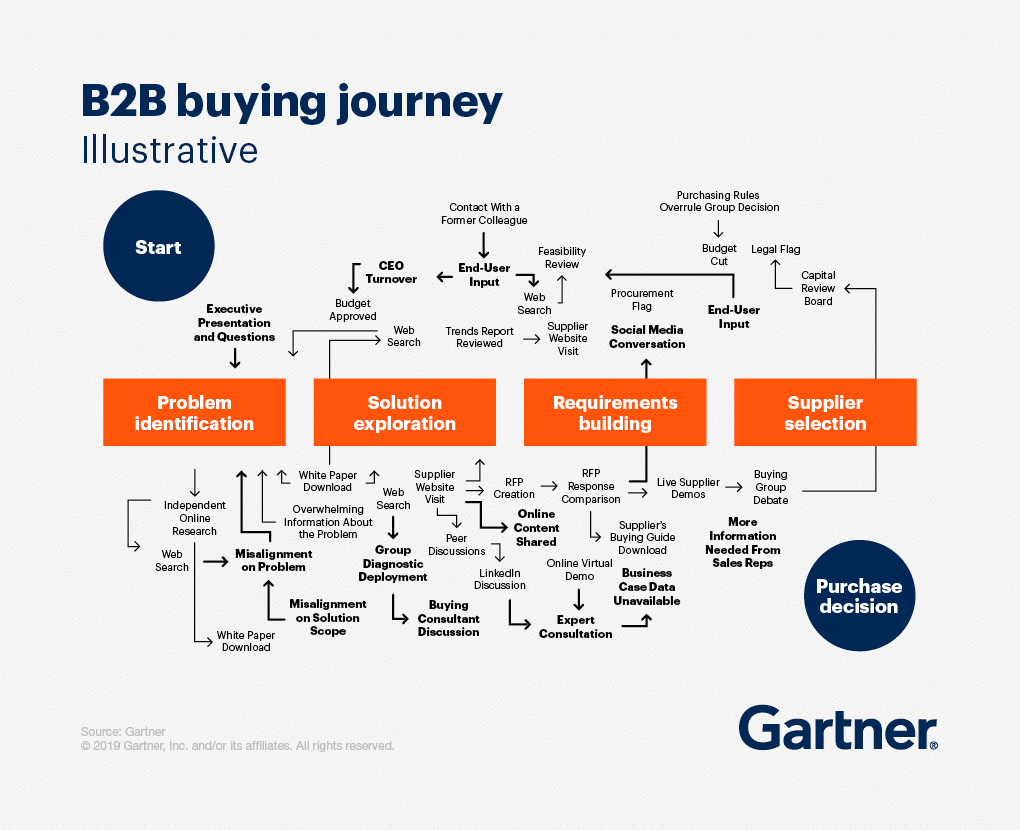Understanding the B2B buying journey is important for salespeople because it determines how they sell to their prospects. To find out where a prospect is in the buying journey, you need to ask them questions and do some research to gather intelligence about their company.
Companies need to understand how B2B buyers think before they design the perfect customer experience. The key is to have a holistic view of their needs, and not just have them figure it out as they go along.
The illustration below is a typical buyer journey from start to purchase decision and a good thing to note is that it is never linear.

Source: Gartner
A use case of understanding a buyer journey would involve:
- The problem statement or pain point the customer is trying to address
- Tailoring your content with what customers search online
- Mapping customer journeys with data-driven insights
- Continually adapting to dynamic behavior and needs of customers
You have to create a perfect customer experience in line with buyer journeys to help differentiate your business from others.
Typically buyer journey can be mapped with the following three stages in the buying process.
1. Creating Awareness for Prospective Buyers
Think of the awareness stage of a buyer journey as a way for your potential customers to get familiar with your product or service. It’s all about getting more information on what you have to offer and figuring out how it might benefit them—if at all.
So in this stage – what is the buyer journey like? If a customer is in the awareness stage, they’re likely to be gathering information about a product or service and asking questions about themselves and others. So you need to pay attention to what kind of information they’re looking for when marketing your product or service.
Usually at this stage customers in your product niche are doing a lot of online research. It would be best at this stage to gather intelligence on what they are searching online and aligning your services with the pain points you can address.

Source: LeadsBridge
It is observed that 72% of B2B buyers turn to Google for educational material, customer reviews, and testimonials.
You could employ marketing automation tools for tracing content downloads and collecting prospect information and preferences. As for tacking behavior outside your marketing ecosystem, you can quickly rely on independent third-party research.
2. Channelizing Buyers towards Consideration
The consideration stage of the B2B buyer journey is a period in which both parties take time to evaluate each other and learn more about their needs. In the consideration stage, the buyer may be interested but not yet engaged or ready to commit to doing business with you. You, as a seller, should use this time to learn more about their needs and show them that your company has what they need.
The consideration stage of the buyer journey is something that needs to be understood to make an educated guess on how to tailor your marketing strategy around it.
At this juncture, you would mainly want to focus on engagement within your marketing ecosystem. This is the right moment for lead scoring and keeps track of their growing interest. Data is going to be your key ally to find the opportune moment to pitch in with your nurture and drip campaigns.
To gain insights into what your prospects are comparing your services with it is best to source intent data from providers like us. Tracking their online behavior, the budget spends, and activates on their social handles would give you ample ammunition to tune your product demos so that you can narrow them down to features specific to your prospect’s needs.
Key decision-makers and C-suite will be jumping into the bandwagon at this point of the customer journey and it calls for tweaking the content strategy around them.
3. Driving Key Decisions
The decision stage is part of the buyer journey when a business decides which vendor they are going to choose. They can either purchase the product or service, have an in-person meeting, or are just deciding whether to go with a specific vendor or completely drop the idea of making a purchase.
At this point, the buyers are mainly concerned about preparation, implementation, customer support, and quick-start costs – a quick assessment to see the solution meets their needs and budget.
This stage of the buyer’s journey is important because it determines what happens next for the business and how successful their decision will be. It is imperative that businesses not slouch on this stage because it might have lasting implications for them in terms of sales, profits, etc.
The decision stage is where the customer has had enough information and they make a buying decision in the B2B buying process. This is the final stage in the buyer journey, and it can be considered to be where conversion occurs.
To channelize your customers through this stage requires you to be brand-specific with your content to drive forward great customer experiences (CX).
In Conclusion
Businesses can successfully increase their customer acquisition by understanding their customers’ needs and motivations. It’s time you get started with your research into your company’s buyers’ journeys.
By making many successful customer journeys possible you can funnel in more leads by keeping your sales in the auto piolet mode – as your newly turned customers become the brand ambassadors of your products and services.


